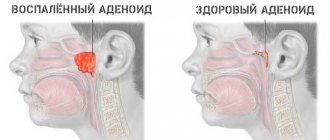Causes of congestion
To establish the causes of nasal congestion, it is necessary to understand what preceded this condition. The following factors matter:
- contacts with an infected person;
- exposure to allergens;
- hypothermia;
- prolonged inhalation of dry air;
- features of the diet.
To assess the general condition, you should measure the child’s temperature, analyze activity and appetite.
ARVI
This condition is considered the most common cause of problems. In the first 2-3 days of the illness, the baby develops nasal congestion. The pathology has not yet fully manifested itself, but inflammation of the mucous membranes has already occurred.
Allergic rhinitis
This condition appears at certain times of the year - most often in the spring. However, there are other allergens that can be active throughout the year. These include wool, food, and house dust. To determine the causes of the disorder, the child should be shown to an allergist.
Overgrowth of adenoids
Under the influence of various factors, these elements may increase in a child. The mucus that is released begins to flow down the back wall of the nasopharynx. At the same time, the nose gets blocked at night, the child is forced to sleep with his mouth open. He may wheeze. If such a clinical picture appears, you should definitely consult a doctor.
Polyps
When these benign formations appear in the baby’s nose, there is chronic congestion. It can be temporarily eliminated with drops. However, such drugs cannot completely solve the problem. In addition to congestion, there is general weakness, impaired sense of smell, and frequent ENT pathologies.
Often, polyps provoke compression of blood vessels, which leads to disruption of the blood supply to tissues. As a result, swelling occurs. When the auditory tubes are damaged, hearing and speech disorders occur. Such signs are very dangerous for young children. Often the formation of polyps provokes a change in bite.
Sinusitis
With this disorder, mucus does not flow from the nasal sinuses. In this case, a headache is observed. Nasal congestion does not go away for quite a long time, which only aggravates the condition of the little patient. In such a situation, you should immediately consult a doctor. To cope with sinusitis, it is often necessary to use antibiotics.
Stuffy nose? - This is problem
You should breathe through your nose - this is how the human body works. The air in the nose is warmed, moistened, and dust and harmful microorganisms are retained.
With free nasal breathing, the breathing rhythm slows down, which helps lower blood pressure; Air leaves the lungs more slowly, allowing the body to extract more oxygen from it. If we breathe through our mouths, then, on the contrary, cold, or dusty, or dry air immediately enters the throat, irritating the mucous membranes and contributing to the development of symptoms of pharyngitis, laryngitis and tonsillitis.
Meanwhile, quite often nasal breathing in children and adults is difficult. However, constant nasal congestion is often not perceived as a problem. We get used to breathing through our mouths and consider this situation normal. First of all, this applies to children - if a child has a stuffy nose, he is unlikely to complain about it. So parents should take a closer look at how the child usually breathes - through the mouth or nose.
Sometimes nasal congestion can be caused by a combination of reasons. It happens that even a medical examination does not completely clarify the situation. In these cases, endoscopic examination is recommended.
What to do if your child has difficulty breathing
If nasal congestion occurs, it is imperative to take appropriate measures. The famous children's doctor Komarovsky recommends systematically ventilating the room, as well as monitoring humidity and temperature parameters.
In addition, following these rules will help improve your baby’s condition:
- Drink a lot - this will help make nasal discharge more liquid;
- walk more in the fresh air;
- rinse your nose with saline solution;
- put healthy oils in your nose - peach or olive.
If after 5 days nasal breathing has not been restored, you should definitely consult a specialist.
Traditional Treatments
To choose the right therapy, you need to analyze other symptoms of the pathology.
The baby may experience itching, watery eyes, and a burning sensation. In this case, congestion may be a manifestation of an untreated respiratory disorder. If breathing problems occur due to a cold, special solutions and vasoconstrictors are used to eliminate the discomfort. These include galazolin, tizin, etc. Such products can only be used as prescribed by a doctor.
Experts do not recommend using such drugs for more than 3 days . Longer use may lead to addiction. As a consequence, there is a threat of atrophic changes in the structure of the mucous membrane.
Treatment of diseases that caused the problem
There are several ways to cure a runny nose in a baby. It depends on the reasons why the problem occurred. First of all, it is necessary to create the right atmosphere in the baby’s room. Namely, to refresh the room, raise the humidity to acceptable standards.
For the treatment of infants use:
Drops
Drops that constrict blood vessels in a baby. But you should remember that such a drug should be taken only after the recommendation of a specialist. Because there are a number of medications that can be taken by children over two years of age.
Nasal rinsing
Very often, small children are prescribed nasal rinsing using special solutions. For the youngest children, similar drugs are produced in special bottles that have a dispenser. This makes rinsing very convenient.
Aspirators
In order to rid the baby of mucus, you can use aspirators, in other words, nozzle ejectors. These drugs are divided into:
- Syringes. This item is a rubber bulb with a tip. This method has been used for a long time, but it is considered unreliable, since such an aspirator could damage the baby’s nasal mucosa, and they do not have a dispenser for suctioning out mucus.
- Mechanical aspirators. In this case, the device is a glass tube with which the mother sucks out the mucus with her mouth. There is a reservoir into which it goes
- Electronic aspirators. Such devices are very convenient to use, since with their help the mucus is sucked out much easier. In this case, you just need to press a button. The only drawback is the fragility of the device.
- Vacuum aspirators must be attached to a vacuum cleaner to be used. This procedure causes fears among parents, but, nevertheless, this method is good in that the device itself regulates its operation and cleans the baby’s nose well.
Useful folk remedies
To cope with nasal congestion, you can use the following remedies:
- Aloe . The juice is squeezed out of the leaves of this plant and mixed with water in equal proportions. For nasal congestion in children, the drug is instilled three times a day. Thanks to this, it is possible to improve the condition and stop the inflammatory process.
- Beet . You need to squeeze the juice from this vegetable and mix it in equal parts with water. Drop into the nose three times a day. If a burning sensation occurs, you need to dilute the product even more. You can also use boiled beet juice. It doesn't have that sharpness.
- Egg . It needs to be boiled and applied to the nose. It is necessary to keep the product until it cools.
- Sea salt . Take 1 tablespoon of this product and mix with 1 liter of water. Use the resulting rinse solution.
- Chamomile . This product perfectly restores breathing. Chamomile decoction is perfect for rinsing the nose. You can soak a cotton swab in the product and place it in your nose for 20 minutes. To prepare the infusion, take 1 large spoon of flowers and add a glass of cold water. Infuse the product for 8 hours. However, the nose should only be instilled with a warm solution. It is recommended to strain the product before use.
- Onion . Take a medium onion and squeeze the juice out of half. Mix in equal parts with water and apply to the nose up to 5 times a day. It is prohibited to use the product in its pure form, as it can cause a burn.
Nasal congestion without runny nose
26.11.2020
Sometimes it happens that you get up in the morning, but through your nose ... Although yesterday there seemed to be no illness, and even now you feel fine. It's even more disgusting if you can't blow your nose. just stuck like a lump in my nose . So what to do? The nose is stuffy, runny nose ... Some kind of paradox. It is useful to learn about the causes of this phenomenon and methods to combat it.
When you are trying to independently determine what could have caused such a paradox, do not forget that a stuffy nose is just a symptom and can be characteristic of a great variety of diseases. Various discomforts may appear as accompanying symptoms, for example, the nasal cavity may itch or burn from the inside, or tears may flow for no reason; migraines are also possible. Such manifestations can last for many tens of days until you begin adequate treatment. Sometimes a stuffy nose indicates an incompletely cured illness, which itself has long passed.
Causes of nasal congestion
Let's look at the two most likely reasons why nasal without a runny nose .
First of all, these are untreated or severely suffered respiratory diseases or sudden exacerbations due to the powerful impact of unfavorable conditions. If this is indeed the case, try using basic nasal . In any pharmacy, the pharmacist will advise you on a huge selection to suit every taste and budget.
But if you know that your body has a predisposition to any type of allergies, most likely your nose is constantly stuffy from their effects.
How to get rid of nasal congestion?
Doctors most often advise using various pharmaceutical nasal , but, as a rule, most of them only temporarily relieve nasal , while other accompanying symptoms remain or even intensify. Be careful as there are a number of nasal sprays that can be addictive if used over a long period of time.
There is a false belief that sucking tablets in the form of candies help cope with a stuffy nose . This opinion is almost always wrong and has a positive effect only if the cause of the disease lies in the throat .
If you cannot overcome the problem for some time, consult a doctor . He will quickly determine why your nose and prescribe appropriate treatment. And most importantly, the hospital can detect sinusitis or frontal , and surgical intervention will not be required to eliminate them.
the nose can be affected is located on the soft part of the palm , which precedes the thumb. To get rid of nasal , simply massage the area from time to time.
Published in Otorhinolaryngology Premium Clinic
Contraindications
In order not to harm the baby, parents should take into account that it is not recommended to use it for treating children. So, without consulting a doctor, it is prohibited to use the following:
- Antibacterial drugs. Before using medications, you should consult your doctor. Improper antibiotic therapy can lead to the spread of infection and disruption of the microflora.
- Drops with a vasoconstrictor effect. If you violate the instructions for use of such products, the risk of increased dryness of the mucous membranes increases. This will cause the development of medicinal rhinitis.
- Rinse the nasal cavities under pressure. You should not use a syringe or syringe for this purpose. Do not inhale too much fluid through one nasal opening. In this case, there is a risk of infected solution getting into the ear. This can lead to otitis media.
- Oil inhalations.
- Herbal infusions. The use of such products for rinsing the nasal passages increases the risk of developing allergies.
Article on the topic - what to do if it is difficult to breathe.
Why might your nose be stuffy?
The fact that the nose is constantly stuffy can be caused by a number of reasons, including:
- deviated nasal septum
. The nose is quite vulnerable; the resulting injury can easily lead to a displacement of the septum. Sometimes the nasal septum is deformed at birth, and a person lives with a displaced septum all his life. The shape of the septum can also be disrupted in adolescence, during a period of intensive growth, since its posterior, bony part grows more slowly than the anterior cartilaginous part. - Adenoids
(adenoid growths). In children who are often ill or have suffered a serious infectious disease (measles, whooping cough, scarlet fever, influenza), the nasopharyngeal tonsils can grow, partially or even completely blocking the lumen of the nasopharynx. - Polyps
. Growths in the nose that arise as a result of prolonged exposure to inflammation on the mucous membrane. Seen most often in adults. - Chronic rhinitis
. Rhinitis is an inflammation of the nasal mucosa, which manifests itself primarily in the form of a runny nose. A runny nose can be caused by a viral, bacterial or fungal infection. Chronic runny nose can be of an allergic nature or result from improper use of medications (for example, abuse of vasoconstrictors). - Chronic sinusitis
is inflammation of the paranasal sinuses. - Chronic tonsillitis
. Sometimes there is no inflammatory process in the sinuses and nasal cavity, but the palatine tonsils are inflamed, and the discharge that forms on them makes breathing difficult. - Tumors of the nasopharynx
. - Narrow nasal passages
.
Sometimes nasal congestion can be caused by a combination of reasons. It happens that even a medical examination does not completely clarify the situation. In these cases, endoscopic examination is recommended.
Possible complications
If a child has nasal congestion for a long time, there is a risk of dangerous complications. These include the following:
- Impaired sense of smell, hearing and speech.
- Hypotrophy. It develops if there is weight loss in a newborn baby due to insufficient nutrition.
- Impaired physical condition. This may be the result of prolonged hypoxia. An insufficient amount of oxygen in the internal organs leads to disruption of their formation and progression of dysfunction.
- Inflammation of the lower part of the respiratory system. This is caused by inhaling cold, unpurified air through the mouth.
- Impaired intellectual capabilities. This creates difficulties with the perception of school material.
The risk of complications is quite high in children with complex autoimmune pathologies and congenital immunodeficiency.
Nasal congestion is a fairly serious condition that can cause negative consequences. To avoid complications, you need to start treatment for this condition on time, and for this you should consult a doctor.











